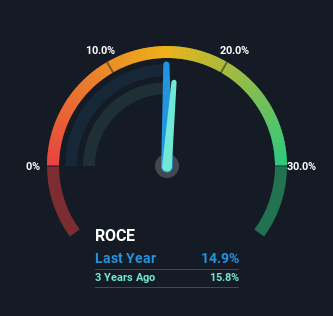- United States
- /
- Luxury
- /
- NYSE:HBI
Slowing Rates Of Return At Hanesbrands (NYSE:HBI) Leave Little Room For Excitement

What are the early trends we should look for to identify a stock that could multiply in value over the long term? Firstly, we'd want to identify a growing return on capital employed (ROCE) and then alongside that, an ever-increasing base of capital employed. Ultimately, this demonstrates that it's a business that is reinvesting profits at increasing rates of return. However, after investigating Hanesbrands (NYSE:HBI), we don't think it's current trends fit the mold of a multi-bagger.
Understanding Return On Capital Employed (ROCE)
For those that aren't sure what ROCE is, it measures the amount of pre-tax profits a company can generate from the capital employed in its business. The formula for this calculation on Hanesbrands is:
Return on Capital Employed = Earnings Before Interest and Tax (EBIT) ÷ (Total Assets - Current Liabilities)
0.15 = US$750m ÷ (US$7.1b - US$2.1b) (Based on the trailing twelve months to October 2022).
Therefore, Hanesbrands has an ROCE of 15%. That's a relatively normal return on capital, and it's around the 18% generated by the Luxury industry.
View our latest analysis for Hanesbrands

Above you can see how the current ROCE for Hanesbrands compares to its prior returns on capital, but there's only so much you can tell from the past. If you'd like, you can check out the forecasts from the analysts covering Hanesbrands here for free.
What Does the ROCE Trend For Hanesbrands Tell Us?
Things have been pretty stable at Hanesbrands, with its capital employed and returns on that capital staying somewhat the same for the last five years. This tells us the company isn't reinvesting in itself, so it's plausible that it's past the growth phase. So don't be surprised if Hanesbrands doesn't end up being a multi-bagger in a few years time. This probably explains why Hanesbrands is paying out 41% of its income to shareholders in the form of dividends. Given the business isn't reinvesting in itself, it makes sense to distribute a portion of earnings among shareholders.
The Bottom Line
In a nutshell, Hanesbrands has been trudging along with the same returns from the same amount of capital over the last five years. And investors appear hesitant that the trends will pick up because the stock has fallen 66% in the last five years. On the whole, we aren't too inspired by the underlying trends and we think there may be better chances of finding a multi-bagger elsewhere.
Hanesbrands does have some risks, we noticed 3 warning signs (and 2 which are concerning) we think you should know about.
If you want to search for solid companies with great earnings, check out this free list of companies with good balance sheets and impressive returns on equity.
Valuation is complex, but we're here to simplify it.
Discover if Hanesbrands might be undervalued or overvalued with our detailed analysis, featuring fair value estimates, potential risks, dividends, insider trades, and its financial condition.
Access Free AnalysisHave feedback on this article? Concerned about the content? Get in touch with us directly. Alternatively, email editorial-team (at) simplywallst.com.
This article by Simply Wall St is general in nature. We provide commentary based on historical data and analyst forecasts only using an unbiased methodology and our articles are not intended to be financial advice. It does not constitute a recommendation to buy or sell any stock, and does not take account of your objectives, or your financial situation. We aim to bring you long-term focused analysis driven by fundamental data. Note that our analysis may not factor in the latest price-sensitive company announcements or qualitative material. Simply Wall St has no position in any stocks mentioned.
About NYSE:HBI
Hanesbrands
A consumer goods company, designs, manufactures, sources, and sells a range of range of innerwear apparels for men, women, and children in the Americas, Europe, the Asia pacific, and internationally.
Reasonable growth potential and fair value.
Similar Companies
Market Insights
Community Narratives




